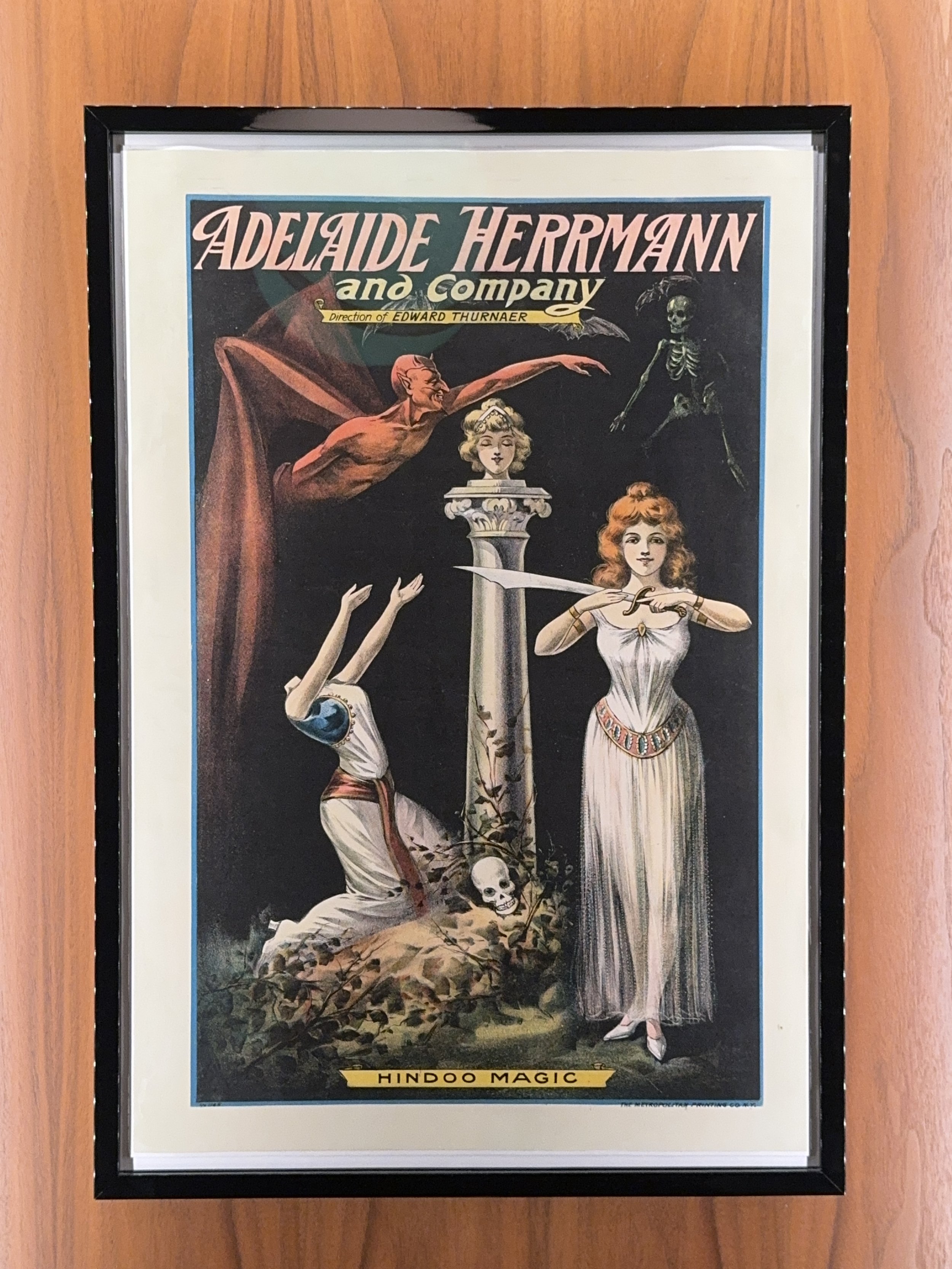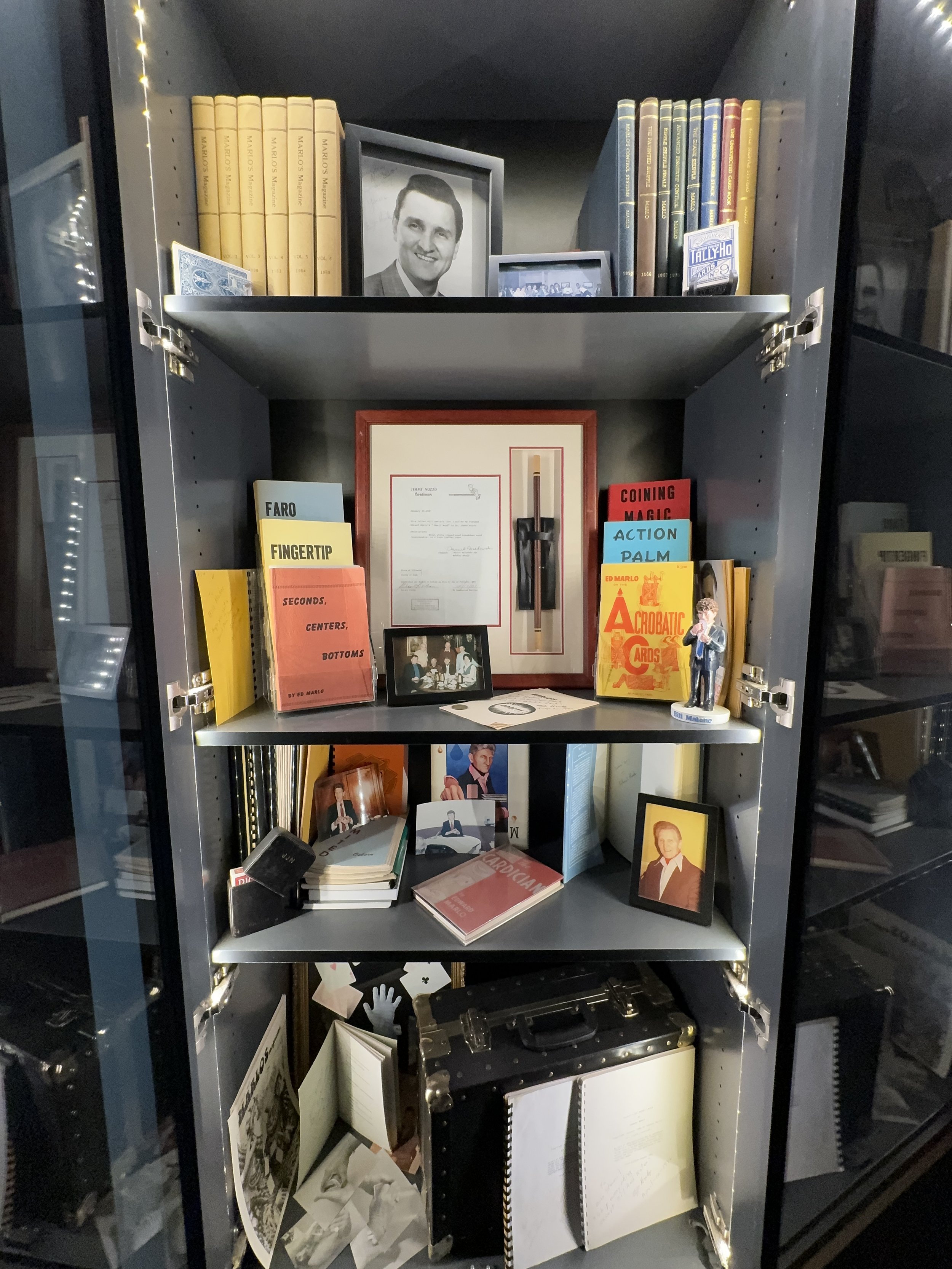
MAgicians D - M
DANTE (Harry August Jansen)
have you seen dante?
Unknown Printer, Circa 1940s.
In 1922, magician Howard Thurston, realizing Harry Jansen's talent and possible competition to him, engaged Jansen to star in the #2 Thurston show. Thurston gave Jansen the stage name Dante, which he would use for the rest of his life. The clever question mark devil artwork sports a cartoon likeness of Dante.
DANTE (Harry August Jansen)
The Mysterious Dante
Adolf Friedlander, Circa 1936.
During the 1930s, Dante arguably had the greatest magic show in the world. He had already been touring Europe for about six years, and World War II was the only thing that forced him home. The riotous artwork evokes the exotic spectacle you should expect for your ticket price.
Read about Dante’s rise to fame and the end of an era.
GEORGE, GROVER
George, The Supreme Master of Magic
Otis Litho., Circa 1926.
The images and symbols are timeless and intriguing, even to modern audiences. George promises mysteries from around the world, including the spirit realm. In the early 1920s, Grover George's American Tour failed due to the interference of Howard Thurston, the most famous magician of the day. Thurston told theaters they would never have him on their stage again if they booked George. The defeated George decided to embark on a South American Tour. It was a huge success. He returned in 1929, performing in second-rate venues until he eventually returned to South America. George retired to Sao Paulo, Brazil, to run a successful business manufacturing movie projectors and was also involved in Brazilian TV.
Learn more about George, the supreme master of magic, a magician in exile.
HERRMANN, ADELAIDE
Adelaide Herrmann and Company
Metropolitan Litho. of New York, Circa 1915.
After her husband's death, Adelaide partnered with her nephew, Leon Herrmann. The partnership lasted only three years. Adelaide then took out her own show. She was a fine magician on her own and quickly became a popular vaudeville headliner. She was one of the few women to perform the legendary and dangerous Bullet Catch.
Learn more about the remarkable life and career of Adelaide Herrmann, the Queen of Magic.
Learn more about the history of women in magic.
HUGARD, JEAN
Hugard the magician
Melbourne & Sydney: Syd Day the Printer, Circa 1920.
Mostly famous among magicians as a writer and editor, Jean Hugard wrote over 30 magic instructional books. The Australian-born Hugard began his performing career in the 1890s. In 1915, he moved to the United States and worked in vaudeville. He owned and performed in a magic theater in Luna Park (at Coney Island) from 1919 to 1929. He also was known for his bullet catch routine, which he was the first to present it with modern-day guns.
Learn more about the true magician’s magician, Jean Hugard.
JANSEN (Harry August Jansen, Dante)
The Great JAnsen
American Show Print, 1911.
A full line of advertising was produced for his first world tour, thus the title "American's Greatest Transformist." He is shown performing Servais LeRoy's "Three Graces" or what is today known as "Things Go Bump in the Night." It is a production of three people with an astonishing transposition at the finish.
Read about Jansen’s career and rise to fame as the great Dante.
KELLAR, HARRY
Kellar’s Startling Wonder
Strobridge Litho of Cincinnati, 1894.
This rare lithograph depicts Harry Kellar performing the mysterious "Cassadaga Propaganda," one of his most successful séance-inspired illusions. It is a miniature spirit cabinet. The cabinet starts flat and is then folded into shape. Seconds after the doors are closed the "spirits" ring bells and shake tambourines, throwing them out after tiring of the clatter. A handkerchief is knotted and placed in the emptied cabinet. It immediately comes to life, moving about the cabinet, peeking out the windows, and finally leaving the cabinet and floating around the floor like a miniature ghost.
Read more about America’s Second Great Magician, Harry Kellar.
WHAT IS THE “MANTLE OF MAGIC?”
PROFESSOR LÉNO
PROFESSOR LÉNO
Naboulet, 1926.
There was an old tradition of magicians using the title "Professor" to indicate their expertise in magic and not their higher education. Léno advertises that he has a "degree" from the French Society for the Study of Psychic Phenomena, a protege of magic dealer and performer Professor Caroly. The use of "magnetizer" in the copy may denote a hypnotism component to the show, besides magic and spiritualism effects.
MARLO, ED
ASSORTED EPHEMERA
Signed books and pamphlets, various publications, decks of cards owned by Marlo, Marlo’s wand
Some of the most significant contributions to the evolution of the magical arts have come from amateurs. While professional magicians spend their time honing their tricks and taking care of the business of show, amateurs have time to tinker and create. Professionally, Edward Marlo was a machinist. He was also a magician who specialized in magic with playing cards. Marlo wrote over sixty books and manuscripts and contributed over 2000 tricks to the field of card magic. Meticulously working out every possible variation, he created a toolbox full of new techniques and tricks influencing a young generation of highly skilled card magicians.
MARO, EDWARD (Walter Truman)
MARO, PRINCE OF MAGIC (FLAGS)
Goes Litho., 1906.
Very unusual horizontal window card of Edward Maro printed on cardboard so it could stand up in a store window. Edward Maro is shown presenting two of his featured effects, Flags of the World and The Meteoric Ribbons. The production of the flags of the world, ending with a large American flag and the playing of the national anthem, assured many acts of a standing ovation finale.
MARO, EDWARD (Walter Truman)
MARO, PRINCE OF MAGIC (INCUBATION)
Goes Litho., 1906.
Walter Truman Best became the most successful magician in the Lyceum field under the name Edward Maro. By 1905, He was earning an astounding $3000 a month, but his life was tragically cut short by Typhoid Fever at just 39 years of age.
Learn about the brief life of Edward Maro, The prince of MAgic.
MARSHALL, FRANCES IRELAND
ASSORTED EPHEMERA
Jo-Anne Hamilton Duck, Linking Rings, reading glasses, silhouette of Frances Ireland Marshall, lifetime achievement awards from Society of American Magicians, Assembly 3, and The Academy of Magical Arts, various magic props
Frances Ireland Marshall was an icon among all kinds of magicians—performers, dealers, creators, writers — for decades. In 1931, Francis Marie Ahrens Vandevier started working at L.L. Ireland Magic Co. in Chicago and eventually married the owner, Laurie Ireland. She became his assistant and then an accomplished magician in her own right, specializing in children's shows. Under her stewardship, Ireland's magic shop became a Mecca of Magic. After Laurie's death, she married Jay Marshall. The shop was renamed Magic, Inc. and is still in business today. Francis once wrote: "I went into magic for what magic could do for me. What I could do for magic became a lifelong compulsion because magic has given me a life so full of riches that I can never repay it."
MARSHALL, JAY
ASSORTED EPHEMERA
“Jay Marshall Signed "Lefty" Glove. [1999] Centerpiece at 30th Annual Magic Collectors’ Weekend in Chicago
Over a 60-year career, Jay Marshall appeared on the Ed Sullivan Show 14 times with his hand puppet "Lefty" He also was the opening act for performers like Frank Sinatra, Milton Berle, and Liberace. In the 1950s, he moved to Chicago and married fellow magician Frances Ireland. Together, they opened a magic shop in 1963 called Magic, Inc. on Chicago's North Side. He amassed a massive collection of books on magic and other interests, a collection of posters and ephemera, and an unparalleled body of knowledge. Magicians, from the most famous to the not-at-all-famous, made the pilgrimage to meet and learn from him. For decades, Marshall's mere presence made Chicago the center of the magic universe.












